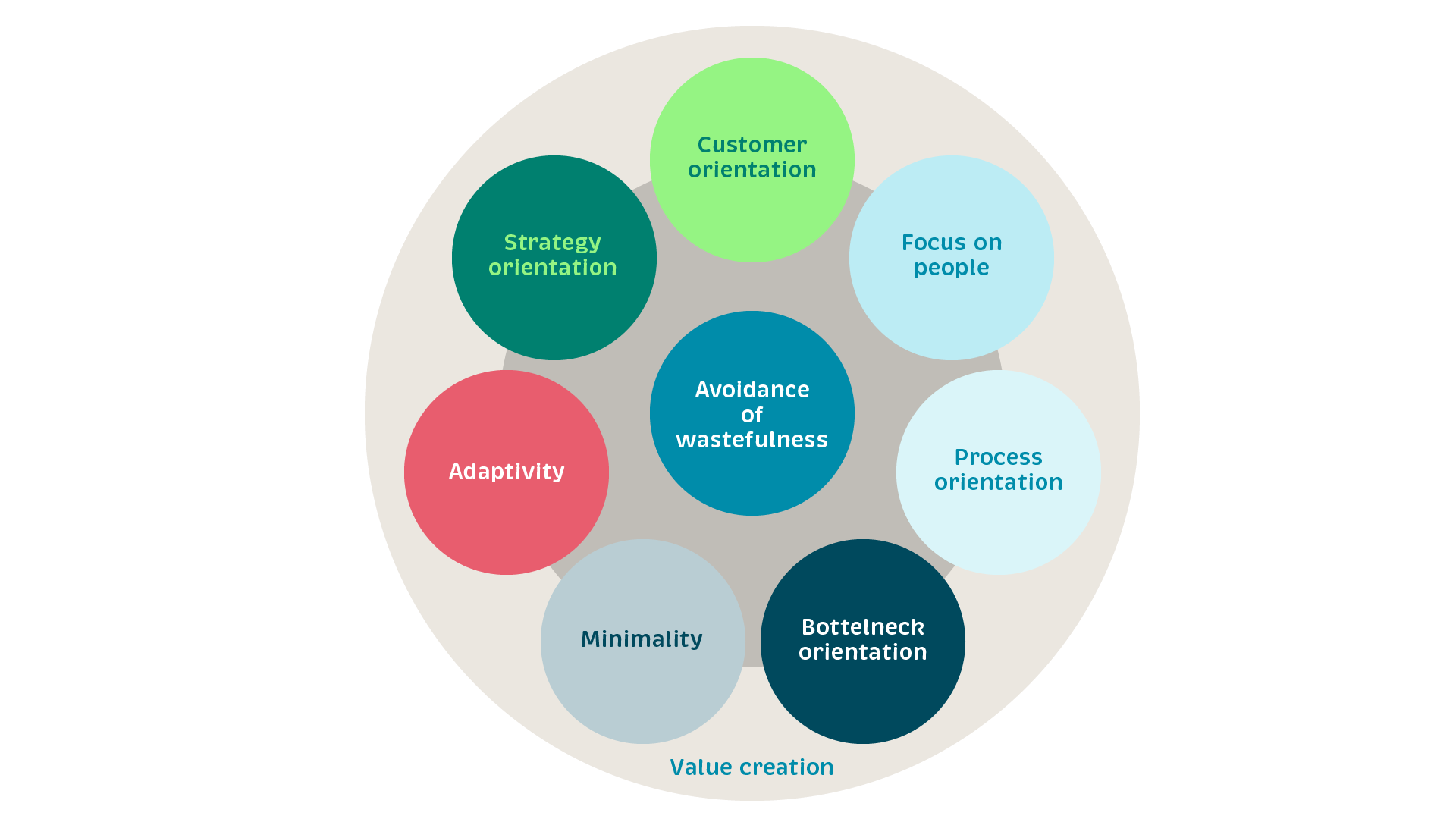Organizations are currently facing numerous global trends and challenges, including digitalization, artificial intelligence, and an increased focus on environmental and social responsibility. In addition, global crises such as the coronavirus pandemic and the ongoing Russia-Ukraine conflict demonstrate how quickly seemingly stable market conditions can change. In this uncertain and complex environment, the demands on market participants' ability to adapt and change are increasing.
These conditions make it much more difficult to plan and manage projects, especially the overall coordination and management of entire project landscapes. Overly strict rules and long-term budgets can be a hindrance or even counterproductive. Project Portfolio Management (PPM) needs to be more dynamic, flexible, and responsive.
To better respond to these changes and remain competitive, a new, more flexible approach to PPM is required. It makes sense to combine agile methods with traditional approaches and to introduce lean principles similar to those used in single project management.
Together with Prof. Dr. Claus Hüsselmann, an expert in project and process management, I have worked intensively on this topic. The result is a canon of principles that should help to make project portfolio management more efficient and agile. In order to develop these principles, numerous user reports and well-known best practices technical presentations were analyzed and used as a basis. The core principles were selected based on the most important success factors and the goals they are intended to achieve.
The focus is on eliminating waste by focusing on value creation. To this end, seven core principles were formulated, which together form a lean-adaptive philosophy.
The principles of the Lean-Adaptive Philosophy

Putting the principles into practice requires appropriate methods and practices. In the following, the core principles are explained and examples of their practical implementation are given. A detailed description of the presented methods will be given in future articles. Stay tuned!
The principles with further details and application notes as well as a holistic process and principle-oriented reference model can be found in the recently published book by Dr. Claus Hüsselmann:
Name: Lean-Adaptive Project Portfolio Management - Ein prozess- und prinzipienorientiertes Referenzmodell (Autor: Claus Hüsselmann, Verlag: Schäffer-Poeschel, ISBN 978-3-7910-5934-1)
Strategy Orientation: Why should a (project) service be delivered?
The principle of strategy orientation states that only projects that fit the corporate and PPM strategy should be implemented. This means that the implementation of PPM components must be in line with the previously defined strategy. This prevents PPM from approving projects that are profitable in the short term, but do not add real value to the business in the long term.
By consistently taking the strategy into account when selecting and implementing the right projects, you can ensure that the company remains sustainable and successful over the long term.
Examples of the practical implementation of strategy orientation include scoring models for prioritizing and selecting projects, as well as a clear focus on benefits and results. A more detailed description of these methods will follow in a future blog post. Stay tuned!
Customer focus: Who is the (process) customer?
The principle of customer orientation focuses on understanding your customers and aligning the solutions offered with their benefits. Customers are all those who receive services from the project portfolio, initiate the service process and influence the acceptance of the portfolio.
All activities should be focused on the needs of customers, which can be both external and internal. A key objective of this principle is to build long-term and stable customer relationships. To achieve this, customers' needs and wants are regularly gathered and analyzed so that the company's actions can be adapted accordingly.
Examples of methods that support the principle of customer centricity include user stories and design thinking to accurately capture user needs and define project requirements accordingly.
Process Orientation: How is the service delivered?
Process orientation emphasizes that the company's actions and processes must be focused on value creation. Value creation includes all activities that increase the value of a product or service in the interest of the (process) customer.
The goal is to "flow" the execution of processes, avoiding stagnation and excessive delays. Implementing process orientation requires teamwork and delegation of responsibility. It is not about controlling the "how" of work, but about aligning all work processes with value creation and the associated value streams.
Examples of implementing process orientation include methods such as Portfolio Kanban and holistic product and value stream-oriented organizations. These approaches help ensure that every step in the process contributes to value creation.
Bottleneck orientation: What limits throughput?
Every service creation process has a bottleneck that limits throughput and therefore overall performance. Bottleneck orientation focuses on avoiding multitasking, balancing workloads, and freeing up space - especially by limiting work-in-progress (WiP).
Too much multitasking is detrimental to business success.
Examples of the bottleneck orientation principle include setting WIP limits and the planning of time buffers after projects to first identify and then avoid bottlenecks, thereby increasing efficiency.
Adaptivity: What approach does the context of the system require?
The principle of adaptivity allows the system, planning and methods to adapt to the situation. Within the PPM system, it is essential that the "Check → Do" process is repeated regularly. This means that the PPM strategy is not set in stone, but can be flexibly adapted to new requirements.
Decisions about the implementation of projects should also be made in a way that does not unnecessarily restrict this adaptability. They should leave room for new projects, changing conditions, or newly acquired knowledge.
Examples of adaptability are rolling planning in portfolio sprints and regular sharing. Rolling planning allows plans to be continuously updated and adapted, while regular exchanges within the team ensure that everyone is on the same page and can react flexibly to changes.
Minimality: How does the service (already) achieve its benefits?
The minimization principle limits ancillary activities in the context of PPM. It promotes the idea that "small is beautiful" by reducing project sizes, artifacts, and products as much as possible without compromising customer value. This makes PPM processes easier to manage and improves the cost-benefit ratio.
Examples of minimization include small projects and the Weighted Shortest Job First (WSJF) prioritization method. The idea is that smaller projects are less complex and smaller in scope, allowing for faster implementation and more flexibility for teams to respond to changes.
People orientation: Who will do the project work?
People are the backbone of any organization. Their creativity, innovation, collaboration and commitment are critical to the success of the organization. Therefore, the needs, skills, motivations, and well-being of the people who work in or interact with the system are of great importance.
Putting people first creates an environment where they feel valued and supported. People-centricity requires that people are always at the center of the PPM system. If this human dimension is neglected and too much emphasis is placed on strict rules and processes, the system can become less resilient or even unstable, leading to staff turnover and failure.
Examples that support people orientation include bottom-up strategy development and participation, such as budget planning, to involve employees in decision-making processes, which increases their commitment and buy-in.
The principles can be implemented incrementally. Initially, methods, tools and practices can be introduced that are easy and quick to implement. These first steps provide quick wins and help build commitment and understanding of the principles.
In addition, more extensive organizational changes can be implemented, such as the introduction of a value stream-based organization.
At Campana & Schott, we support you both in the first steps and in comprehensive transformation processes.
Have we sparked your interest?
We invite you to request your free Principles Assessment! In this assessment, we evaluate the maturity level of your principles orientation based on defined criteria. Together, we'll find out how well your principles are


